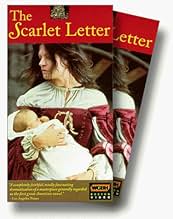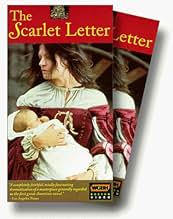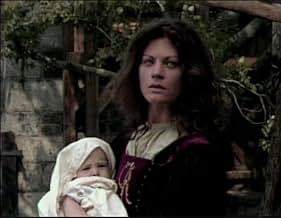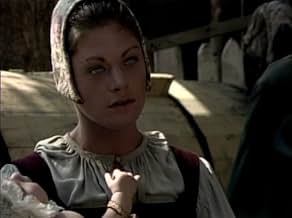Aggiungi una trama nella tua linguaIn Puritan Massachusetts, a woman's husband vanishes. Years later, she has a child from an affair. The town makes her wear a shameful scarlet letter. Her husband returns unexpectedly.In Puritan Massachusetts, a woman's husband vanishes. Years later, she has a child from an affair. The town makes her wear a shameful scarlet letter. Her husband returns unexpectedly.In Puritan Massachusetts, a woman's husband vanishes. Years later, she has a child from an affair. The town makes her wear a shameful scarlet letter. Her husband returns unexpectedly.
- Vincitore di 1 Primetime Emmy
- 1 vittoria in totale
Sfoglia gli episodi
Recensioni in evidenza
John Heard is beautiful and brilliant as Arthur Dimsdale. I though so when I first saw this version of "The Scarlet Letter" when I was eight, and I still think so, having just seen it again. Not since this role has John Heard been in a film which so well showcased his romantic and engaging intensity. That's a shame.
Will a quality version of this classic piece of literature ever be produced? Probably not, as Hollywood these days can't make a movie that doesn't have a happy ending. The drab and drearyness of Hawthorne's work is well related in this version that closely follows the text, even to the point of quoting key lines of dialogue. The most powerful scenes are the meeting between Hester and Chillingworth in the prison, and the conversation between Chillingworth and Dimmesdale where he begins his torturing of the cowardly minister. The main problem with this version is on the technical side.
When Pearl is a baby, she cries incessantly into a microphone that had to have been placed directly next to her. The poor camera quality makes Meg Foster's pale eyes seem psychotic or demonic. The special effects are so ridiculous that the audience can't help but chuckle. A scene between Hester and Chillingworth is nearly drowned out by the ocean nearby. The theme music never changes, and the narration is slow and monosyllabic. Add to that some pathetic acting performances, and there are some scenes that are just hard to sit through. If if weren't for the faithfulness to the text, and that fact that all other versions waver dramatically, this would be unwatchable.
When Pearl is a baby, she cries incessantly into a microphone that had to have been placed directly next to her. The poor camera quality makes Meg Foster's pale eyes seem psychotic or demonic. The special effects are so ridiculous that the audience can't help but chuckle. A scene between Hester and Chillingworth is nearly drowned out by the ocean nearby. The theme music never changes, and the narration is slow and monosyllabic. Add to that some pathetic acting performances, and there are some scenes that are just hard to sit through. If if weren't for the faithfulness to the text, and that fact that all other versions waver dramatically, this would be unwatchable.
John Heard is one of those under-rated actors who deserves more acclaim ... His portrayal of anguished Reverend Arthur Dimsdale was heart-rending and truly unforgettable. Meg Foster and John Heard worked a chemistry the likes of which I have not seen equaled much of late in films. Arthur Dimsdale (so true to the Nathaniel Hawthawne's novel) rends his heart distressingly and is torn literally in two by his inability to act upon his indiscretions brought only partway to light. Meg Foster's Hester Prynne holds tight to a resounding strength, a strength of soul it seems. It is impossible to not feel the powerful emotions, and to hold on tightly to the hope that these two "soul-mates" will once again become one. Keep plenty of tissues handy, especially for Part 3's epiphany of the heart.
I found this to be a most compelling adaptation of Hawthorne's book, with a literate script and good performances by the leads (Meg Foster, Kevin Conway, and John Heard) and many of the supporting players (Penelope Allen, Caroline Cava, and Josef Sommer). The primitive set design and costuming was an attempt to recreate the Salem of the period, and it appears fairly authentic, if my research of the period is any measure of accuracy. The fine music score by John Morris ("Young Frankenstein," "The Elephant Man") aids in creating the proper tragic, somber atmosphere of this classic story.
On the negative side, the momentum sags in Part 3, the use of videotape over film (which the BBC did quite a lot of back then, too) fails to create the necessary atmosphere for a tale with underlying supernatural elements, and the child playing young Pearl is annoying--but so were most child performers of the period.
This are minor quibbles, however, and I still found the production thoroughly engrossing.
On the negative side, the momentum sags in Part 3, the use of videotape over film (which the BBC did quite a lot of back then, too) fails to create the necessary atmosphere for a tale with underlying supernatural elements, and the child playing young Pearl is annoying--but so were most child performers of the period.
This are minor quibbles, however, and I still found the production thoroughly engrossing.
10t.chavez
I saw this series when it first premiered with much fanfare on PBS in the Boston area 20 years ago. I was in my early teens, but the story moved me and has endured as a favorite. I was delighted to see that this version had finally come to video a few years ago, and was as beautiful as I remembered. I get so much more out of the dialogue now, and although the effects are as cheesy as you might expect from a PBS miniseries from over 20 years ago, the music is still affecting, and the performances excellent. It's gorgeously filmed in and around New England, and the "making of" shorts included on the video are a nice touch. As I recall, the story is very close to the original -- a notable difference being the color of Hester Prynne's eyes, which were black in the story, but are light blue in this version. I mention this because Meg Foster's eyes stand out to give her an other-worldly look which is very effective. This miniseries is way up there on my must-see list!
Lo sapevi?
- QuizThe filmmakers' decision to outfit Hester Prynne with a gold letter "A" was sharply criticized at the time of the mini-series' premiere on P.B.S. as author Nathaniel Hawthorne was quite specific about the "scarlet letter" being red-colored. In the novel, the adjective "scarlet" wasn't only used in the symbolic sense (scarlet meaning "grossly and glaringly offensive" in the sense of "sinning in flagrant and scarlet fashion" [deriving from the use of the word in Isaiah 1:18 & Revelation 17:1-6], thus being associated with sexual immorality); the letter sewn onto Hester Prynne's clothing in the novel actually was colored scarlet, albeit it was sewn to her clothing with gold thread. In the words of Hawthorne, "...[W]ith all the townspeople assembled and levelling their stern regards at Hester Prynne, - yes, at herself, - who stood on the scaffold of the pillory, an infant on her arm, and the letter A, in scarlet, fantastically embroidered with gold thread, upon her bosom!" (Chapter Two).
- ConnessioniVersion of The Scarlet Letter (1908)
I più visti
Accedi per valutare e creare un elenco di titoli salvati per ottenere consigli personalizzati
- How many seasons does The Scarlet Letter have?Powered by Alexa
Dettagli
- Data di uscita
- Paese di origine
- Sito ufficiale
- Lingua
- Celebre anche come
- La letra escarlata
- Luoghi delle riprese
- Azienda produttrice
- Vedi altri crediti dell’azienda su IMDbPro
Contribuisci a questa pagina
Suggerisci una modifica o aggiungi i contenuti mancanti



























